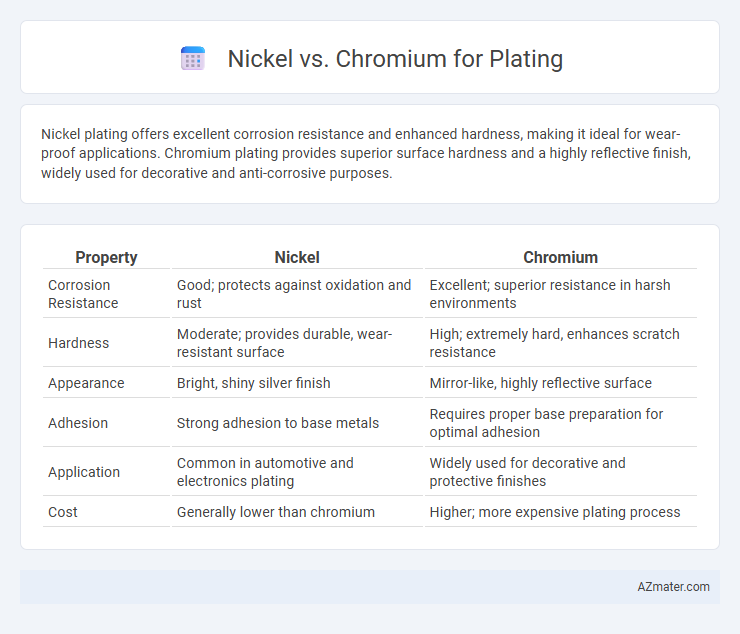Nickel plating offers excellent corrosion resistance and enhanced hardness, making it ideal for wear-proof applications. Chromium plating provides superior surface hardness and a highly reflective finish, widely used for decorative and anti-corrosive purposes.
Table of Comparison
| Property | Nickel | Chromium |
|---|---|---|
| Corrosion Resistance | Good; protects against oxidation and rust | Excellent; superior resistance in harsh environments |
| Hardness | Moderate; provides durable, wear-resistant surface | High; extremely hard, enhances scratch resistance |
| Appearance | Bright, shiny silver finish | Mirror-like, highly reflective surface |
| Adhesion | Strong adhesion to base metals | Requires proper base preparation for optimal adhesion |
| Application | Common in automotive and electronics plating | Widely used for decorative and protective finishes |
| Cost | Generally lower than chromium | Higher; more expensive plating process |
Introduction to Metal Plating: Nickel vs Chromium
Nickel and chromium are two of the most widely used metals in plating due to their distinct properties and applications. Nickel plating offers excellent corrosion resistance and enhances surface hardness, making it ideal for protective and decorative coatings in automotive and electronics industries. Chromium plating provides a bright, mirror-like finish with superior wear resistance and is often used in automotive trim, tools, and hardware for both aesthetic appeal and durability.
Chemical Properties of Nickel and Chromium
Nickel exhibits excellent corrosion resistance and forms a stable oxide layer that protects surfaces from oxidation, making it ideal for plating applications requiring durability and resistance to harsh environments. Chromium, known for its high hardness and exceptional resistance to tarnishing and wear, forms a thin, adherent oxide layer (chromium oxide) that provides superior corrosion resistance and a bright, reflective finish. Both metals' distinct chemical properties influence their plating performance, with nickel offering robust protection against corrosion and chromium delivering a hard, decorative, and protective outer layer.
Types of Plating: Nickel Plating vs Chromium Plating
Nickel plating offers excellent corrosion resistance, enhanced hardness, and improved wear protection, commonly used in automotive and electronic components, while chromium plating is praised for its superior decorative shine and outstanding scratch resistance, often applied in automotive trim and household fixtures. Nickel plating can be either electroplated or electroless, with electroless nickel providing uniform coating thickness and better coverage of complex geometries. Chromium plating primarily employs electrodeposition to produce thin, durable layers that boost surface hardness and resistance to tarnishing without significantly altering the underlying metal's dimensions.
Aesthetic Differences: Finish and Gloss Comparison
Nickel plating offers a bright, white finish with a moderate gloss that enhances the metallic look of surfaces, making it ideal for classic and vintage aesthetics. Chromium plating provides a highly reflective, mirror-like finish with superior gloss, delivering a modern, sleek appearance often preferred for automotive and decorative applications. The chromium finish is more resistant to tarnishing and wear, maintaining its shine longer than nickel in high-traffic environments.
Corrosion Resistance: Durability in Harsh Environments
Nickel plating offers excellent corrosion resistance, especially against acids, alkalis, and saltwater environments, making it highly durable in harsh conditions. Chromium plating provides superior hardness and wear resistance but can be less effective against corrosion if the layer is thin or damaged. Combining nickel as an undercoat with chromium topcoat often optimizes both corrosion resistance and surface hardness for long-lasting protection.
Wear and Hardness: Performance in High-Traffic Applications
Nickel plating offers superior wear resistance and excellent hardness, making it ideal for high-traffic applications such as automotive parts and industrial machinery components. Chromium plating provides exceptional surface hardness and corrosion resistance, enhancing durability in abrasive environments but may be prone to cracking under heavy impact. For applications demanding both toughness and extended wear life, nickel-chromium alloys or duplex plating techniques combine the hardness of chromium with the ductility and wear resistance of nickel.
Cost Analysis: Nickel Plating vs Chromium Plating
Nickel plating generally costs less than chromium plating due to lower material and processing expenses, making it a preferred option for budget-conscious projects. Chromium plating involves higher energy consumption and more costly chemicals, leading to significant price differences between the two methods. When considering long-term investment, nickel's corrosion resistance and durability often offer greater value despite its lower initial cost compared to the premium finish and hardness provided by chromium plating.
Environmental & Health Considerations
Nickel plating poses significant environmental and health risks due to its potential to cause allergic reactions, respiratory issues, and its classification as a probable carcinogen by agencies like the EPA. Chromium, particularly hexavalent chromium used in plating, is highly toxic and carcinogenic, with strict regulations in place to limit emissions and worker exposure. Safer alternatives and improved waste treatment methods are prioritized to mitigate the environmental impact and health hazards associated with both metals in plating processes.
Common Applications: Where Nickel and Chromium Excel
Nickel plating is widely used in automotive parts, electrical components, and household appliances due to its superior corrosion resistance and excellent adhesion to metals. Chromium plating is favored for decorative finishes on automotive trim, bathroom fixtures, and tools because of its high hardness, wear resistance, and brilliant mirror-like appearance. Both metals complement each other in multilayer coatings, combining nickel's protective properties with chromium's aesthetic appeal and durability.
Choosing Between Nickel and Chromium Plating
Nickel plating provides excellent corrosion resistance, superior adhesion, and a smooth, bright finish ideal for decorative and protective applications. Chromium plating, known for its hardness and high wear resistance, delivers a brilliant, mirror-like surface with enhanced oxidation protection. When choosing between nickel and chromium plating, consider the application's durability requirements, desired aesthetic effect, and the level of corrosion protection needed to optimize performance and longevity.

Infographic: Nickel vs Chromium for Plating
 azmater.com
azmater.com